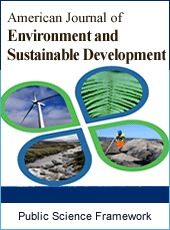American Journal of Environment and Sustainable Development
Articles Information
American Journal of Environment and Sustainable Development, Vol.3, No.1, Mar. 2018, Pub. Date: Jan. 16, 2018
Comparison of Absolute and Relative Variability of F2 Layer Critical Frequency in West Africa Using Ionosonde Station at Ibadan
Pages: 1-5 Views: 2357 Downloads: 596
[01]
Onori Eugene O., Department of Physics, Lagos State University, Lagos, Nigeria.
[02]
Somoye Emmanuel O., Department of Physics, Lagos State University, Lagos, Nigeria.
[03]
Ogungbe Abiola S., Department of Physics, Lagos State University, Lagos, Nigeria.
[04]
Ogwala Aghogho, Department of Physics, Lagos State University, Lagos, Nigeria.
[05]
Ometan Oluwafunmi O., Department of Physics, Lagos State University, Lagos, Nigeria.
[06]
Oguntano Kolawole B., Lagos State University Radiation Monitoring and Protection Services, Lagos, Nigeria.
[07]
Adeniji-Adele Razaq A., Department of Physics, Lagos State University, Lagos, Nigeria.
This paper presents the comparison of the absolute variability (σ) and relative variability (VR) of the critical frequency of F2-layer (foF2) at Ibadan (7.4°N, 3.9°E, 6°S dip) an equatorial station in the West African regionduring years of high, moderate and low solar activities for the seasons represented with the months of March, June, September and December are studied. Diurnal and seasonal variations of the absolute and relative variability obtained are compared. The results showed that relative variability of foF2 is more useful in representing the variability of foF2 than the absolute variability of foF2.
foF2, Absolute Variability, Relative Variability, Solar Activity
[01]
Akala, A. O., Somoye E. O., Adeloye, A. B. and Rabiu, A. B. (2011). Ionospheric foF2 variability at equatorial and low Latiatudes during high, moderate and low solar activity. Indian J. Radio and Space Physics, 40, 124-129.
[02]
Akala, A. O., Oyeyemi, E. O., Somoye E. O., Adeloye, A. B. Adewale, A. O. (2010). Variability of foF2 in the African equatorial ionosphere. Advances in Space Research, 45. 1311-1314.
[03]
Atac, A., Ozguc, A., Pektas, R. (2009). The variability of foF2 in different phases of solar cycle 23. J. Atmos. Solar-Terr. Phys. 71, 583–588.
[04]
Bilitza, D., Obrou, O. K., Adeniyi, J. O., Oladipo, O. (2004). Variability of foF2 in the equatorial ionosphere. Adv. Space Res. 34, 1901–1906.
[05]
Balan N. and G. J., Bailey (1995). Equatorial plasma fountain and its effects: Possibility of an additional layer; J. Geophys. Res., 100, 21, pp 421–432.
[06]
Chandra, H., Som Sharma and Soe Win Aung, (2009). Day to Day variability in the critical frequency of F2 layer over the anomaly crest region, Ahmedabad. J. Ind. Geophys. Union. 13, 217-226
[07]
Chou, Y. T., Lee, C. C. (2008). Ionospheric variability at Taiwan low latitude station: comparison between observations and IRI-2001 model. Adv. Space Res. 42, 673–681.
[08]
Fejer, B. G., Scherliess, L., Paula, E. R. (1999). Effects of vertical plasma drift velocity on the generation and evolution of equatorial spread F. J. Geophys. Res. 104, 19859–19869.
[09]
Fejer, B. G., Farley, D. T. (1979). Dependence of equatorial F region vertical drift on season and solar cycle. J. Geophys. Res. 84, 5792–5796.
[10]
Forbes, J. M., Palo, S. E., Zhang, X. (2000). Variability of the ionosphere. J. Atmos. Solar-Terr. Phys.62, 685–693.
[11]
Fotiadis, D. N., Baziakos, G. M., Kouris, S. S. (2004). On the behaviour of the dayto- day MUF variation. Adv. Space Res. 33, 893–901.
[12]
Jayachandran, B., Balachnadran Nair, R., Balan, N., Rao, P. B. (1995). Short term variability of the ionospheric electron content and peak electron density during solar cycles for a low latitude station. J. Atmos. Solar-Terr. Phys. 52 (13), 1599–1605.
[13]
Kouris, S. S., Fotiadis, D. N. (2002). Ionospheric variability: a comparative statistical study. Adv. Space Res. 29 (6), 977–985.
[14]
Oladipo O. A., J. O. Adeniyi, S. M. Radicella, I. A. Adimula. (2011). Variability of the ionospheric electron density at fixed heights and validation of IRI-2007 pofile’s prediction at Ilorin. Adv. Space Res. 47, 496–505.
[15]
Rishbeth, H., Mendillo, M. (2001). Patterns of F2-layer variability. J. Atmos. Solar-Terr. Phys. 63, 1661–1680.
[16]
Somoye, E. O., Akala, A. O. (2010). NmF2 Variability at Equatorial and Low Latitude Stations: A review Res. J. Phy. 4(2), 50–55.
[17]
Somoye, E. O. (2009a). Comparison of NmF2 variability at Ibadan, Singapore and Slough during different epochs of solar Cycle. Asian J. Sci. Res., 2. 155-160.
[18]
Somoye, E. O., E. O. Onori, A. O. Akala (2013). Comparison of foE and M(3000)F2 variability at Ibadan, Singapore and Slough. J. Atmos. Solar-Terr. Phys. 82, 18–22.
[19]
Zhang, M. I., J. K. Shi, X. Wang and S. M. Radicella (2004). Ionospheric variability at low latitude station: Hainan, China, Advances in Space Science, 34, pp 1860-1868.
[20]
Zhang, S. R., Holt, J. M. (2008). Ionospheric climatology and variability from long-term and multiple incoherent scatter radar observations: variability. Ann. Geophys. 26, 1525–1537.

ISSN Print: Pending
ISSN Online: Pending
Current Issue:
Vol. 6, Issue 4, December Submit a Manuscript Join Editorial Board Join Reviewer Team
ISSN Online: Pending
Current Issue:
Vol. 6, Issue 4, December Submit a Manuscript Join Editorial Board Join Reviewer Team
| About This Journal |
| All Issues |
| Open Access |
| Indexing |
| Payment Information |
| Author Guidelines |
| Review Process |
| Publication Ethics |
| Editorial Board |
| Peer Reviewers |


